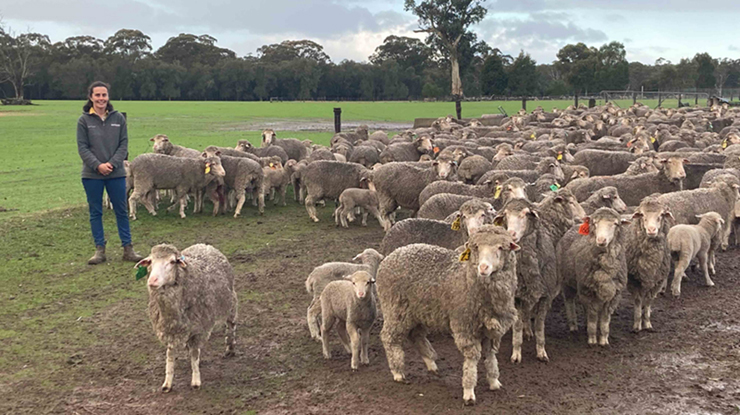Genetics delivers long-term solution to worms
10 December 2024
 Victorian producer Elise Kealy
Victorian producer Elise Kealy
Worm burden can have a significant impact on flock productivity – and while chemical and management solutions to reduce the impact of worms within the flock are effective measures, producers are looking for a more long-term answer.
Genetic selection for a higher resistance to worms can see permanent and cumulative results when used as a tool to combat worms.
WEC breeding value
Australian Sheep Breeding Values (ASBV) are a tool used to describe the genes an animal will pass onto its progeny for a range of traits. They can be used when purchasing rams to make more informed decisions about how a ram’s progeny will perform.
ASBVs are available for a wide range of traits and extend to traits that might otherwise be difficult to assess, including worm egg count (WEC).
The WEC trait has been available as an ASBV for more than 20 years. It’s used by ram breeders and commercial sheep producers to identify animals with a higher level of worm resistance. This can be used with other forms of internal parasite management as part of an integrated pest management (IPM) approach.
WEC backs healthy, productive flock
Genetics have helped manage worms for Victorian sheep producer Elise Kealy, who operates Curlew Merinos at Edenhope along with her parents and brothers.
The family, who operate seedstock and commercial flocks, face worms as a production challenge in their high-rainfall environment, where they receive an average rainfall of 500mm/year (winter dominant).
Elise completed a WormBoss workshop, where she identified major production losses in their business from worms, through reduced lactation, wool production, growth rates and fertility.
Because they do not run any cattle and cropping is only a small percentage of the business (3.5%), other management options are limited – so Elise turned to genetic selection to get the results she was after.
For the past 15 years, Elise has bred for more worm-resistant sheep. The WEC ASBV is an integral part of her breeding objective when selecting sires, and it has delivered tangible and direct results.
“We have been able to reduce our drenching program to one drench per year on average – most sheep producers in our area would drench four or more times a year with many using long-acting drenches,” Elise said.
Drench resistance
In 2008, the family conducted drench resistance tests, and found some combination drenches were only 57% effective for their flock.
Since then, with heavy emphasis on genetic selection for WEC within their breeding objective, Elise is now able to use any drench on the market. This means she does not have to rely on newer, more expensive drench products for efficacy.
“This gives us confidence that selecting for worm-resistant sheep has practical and economic benefits for our business,” she said.
No compromise
Elise hopes the industry can move toward more worm-resistant sheep, to reduce labour requirements and on-farm chemical use – she plays her part by educating her seedstock clients on selecting for WEC.
She encourages her clients to develop balanced breeding objectives, noting that selection for WEC has very little negative impact on other production traits.
This means that genetic gain can be made in WEC without compromising gain in other traits. “WEC is one of the most important traits to select for in our environment,” Elise said.
“It doesn’t matter what your ASBVs are for fleece weight or reproduction, if you have a flock of sheep that are constantly burdened by worms, you will have higher mortality, and produce less wool and lamb. Healthy sheep are productive sheep.”


